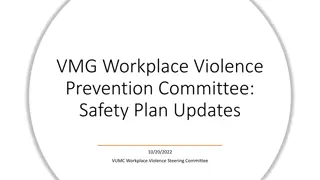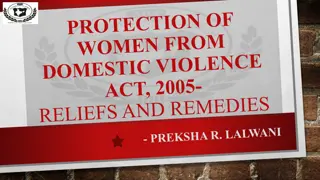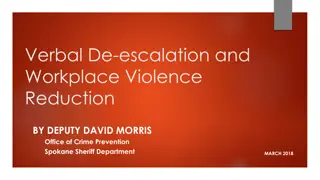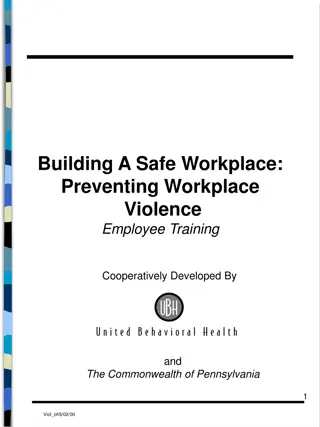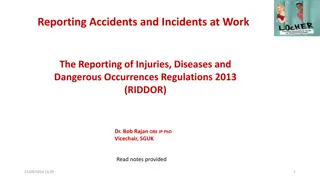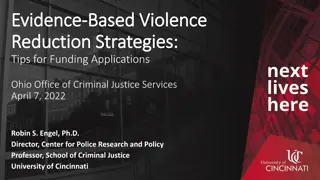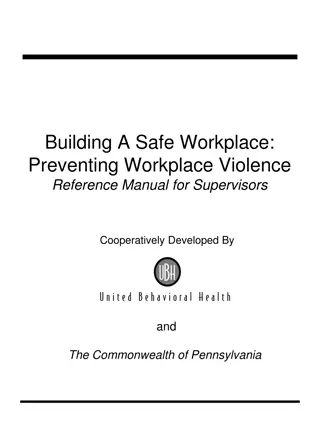Lessons and Practices from Workplace Violence Incidents
Explore the role of health and safety professionals in mass shootings and incidents of workplace violence through the experience of Scott Kalis, the Occupational Safety and Health Services Manager at the City of Virginia Beach. Delve into lessons learned, the impact on occupational safety and health, and the aftermath of a tragic event that claimed 12 lives and left 4 critically injured. Gain insights into the indirect effects on over 400 individuals, including first responders and city workers, and the ongoing occupational safety challenges faced by the organization.
Download Presentation

Please find below an Image/Link to download the presentation.
The content on the website is provided AS IS for your information and personal use only. It may not be sold, licensed, or shared on other websites without obtaining consent from the author. Download presentation by click this link. If you encounter any issues during the download, it is possible that the publisher has removed the file from their server.
E N D
Presentation Transcript
Scott Kalis Occupational Safety and Health Services Manager City of Virginia Beach Office (757) 385-8423 eMail: skalis@vbgov.com
The Role of Health and Safety Professionals In Mass Shootings or Incidents Involving Workplace Violence Lessons Learned and Practices to Share
Our Story from Virginia Beach (Disclaimer What is presented may not directly apply to your organization, so go easy on me ) 4
The basics The basics what was what was directly directly kn known own At approximately 4:30pm on Friday May 31st, 2019 a City Employee walked into his primary work location (Building #2 on the Municipal Campus) and began shooting his co-workers with two handguns. The individual also encountered a citizen contractor who was in the building for a construction/building permit. The shooter proceeded to shoot and kill this one (1) citizen. Eleven (11) City employees were also killed on this day. Four (4) City employees were seriously wounded and in critical condition at the time of the incident. They remain in various stages of long-term recovery. One (1) Police Officer was shot in his ballistic vest and survived. In total: 12 people died and 4 were critically injured. 5
The The indirect indirect effect(s) effect(s) what s not as well known what s not as well known Over 400 people worked in this large building. Primarily in Public Works, Public Utilities, Planning and Information Technology Almost 100 first responders were involved in the incident including Police, Sheriff s Deputies, Fire, EMS, and Dispatchers. Many of those impacted by the incident have filed workers comp claims and have sought mental health treatment for the significant mental strain that the event put on them. Dozens of City workers have retired/resigned from public service since the incident. Some of those separating have been from departments not located in Building-2. 6
Occupational Safety and Health Impact Occupational Safety and Health Impact First Immediate impact to us One of my clinic staff followed me outside during the shooting to render emergency care to a co-worker who had jumped out his 2nd floor office window to escape the shooter and had stumbled across the street to stand in front of our offices (which includes a full occupational health clinic with medical providers). My remaining staff were told to shelter in place and remain sequestered in their locked offices with lights off until we were sure the threat had been neutralized. Second Work to be done Immediately my safety team began staffing the Emergency Operations Center (EOC) as the Safety Officer (SOFR) for the Incident Commander, following standard ICS protocols. My clinical team began working with Humana our EAP contractor and R3 a nationwide contractor for counselors/therapists for resources to stand up services. One of our Human Services leaders was instrumental in collecting over 100 counselors/therapists in the first week after this tragic incident. This key role was held by one of the senior leaders in Human Services who stepped up and was a member of our small team that took on the task of response and recovery. 7
What Can Be Done What Can Be Done Before an Incident Before an Incident Research and Training Bring in SMEs and Trusted Sources (discuss options for your organization) Run, Hide, Fight Active Threat Citizen Defense Some other alternative response program Workforce Training (Who provides? H&S, Police, 3rd Party? Is it required?) 1st Aid/CPR/AED/Stop-the-Bleed Conflict Resolution or Crisis Response (MANDT Based, CIT, or similar) Public Safety Training (Awareness? Who provides?) Rapid Response Teams? Active Shooter or Assailant Drills? (Coordinated with H&S, Facilities?) NIMS/ICS Training for Incident Command structure and operations H&S are typically the Safety Officer directly supporting the Incident Command Know what is expected from your position on command staff Don t assume that public safety is filling this roll in this type of incident 8
What Can Be Done What Can Be Done Before an Incident Before an Incident Establish Partnerships and possible MOUs/MOAs Internal Public Safety (Police/Sheriff/Fire/EMS/Dispatchers) Emergency Management Facilities and Buildings Security (if applicable) External Embedded Contractors (Abacus, Arvon, MedTemps, etc) State and Federal Partners VOSH/VDEQ OSHA/EPA VDEM FBI DHS DCJS 9
What Can Be Done What Can Be Done Before an Incident Before an Incident Exercise the Partnerships and Scenarios Have someone experienced conduct both Table-Top Exercises (TTX) and Actual Active or Field Training Exercises (FTX): Start small with your own team Then, partner with other small entities (i.e., emergency management, legal, others) Routine discussions and meetings will break down many barriers and strengthen the teams. Conduct walk-through discussions and simply ask what if , then pull the threads with a small group to determine where gaps are found. Be open and involve others to provide objective perspective about weaknesses and vulnerabilities. Put egos aside and use these opportunities to learn from the exercises with others. 10
What Can Be Done What Can Be Done Before an Incident Before an Incident Create or Update your emergency action plan (EAP) to connect and cooperate with any existing continuity of operations (CoOP) plan for continuity of government and operations. There are many templates available just pick one and document the plans Exercise the plans at a TTX, and revise them, then re-exercise in a FTX or live exercise with larger group participating. The EAP is a necessary part of an all-hazards workplace assessment and planning to implement the many controls we are used to employing; i.e., engineering controls, administrative controls and safe-work practices, and even use of PPE where other methods won t completely control risk of injury or illness Do you assess Hazards, Threats and Vulnerabilities? Should you be? (That s a YES) 11
What Can Be Done What Can Be Done Before an Incident Before an Incident Actively participate as a key-stakeholder on a Threat Assessment Team (TAT) involving Human Resources, Legal, Law Enforcement/Security, and possibly Facilities or Building Management, as well as mental health professionals. The creation of the EAP is necessary to address certain aspects of an emergency and what the workforce should be focusing on during response to protect and preserve life. The TAT is a group tasked with implementing assessment, intervention, and action policies such as recognition of threatening behaviors and threat reporting mechanisms. 12
What Can Be Done What Can Be Done During an Incident During an Incident Support the Incident Command Structure based upon NIMS/ICS The Safety Officer may be a Public Safety person for many field incidents like motor vehicle crashes, or a working structure fire, etc but if the situation involves the workforce, the Health and Safety professionals should be the designated Safety Officer (SOFR) embedded within the Incident Command structure. Write everything down and take a lot of notes Work to get a scribe or admin assistant assigned to help document all that will be happening. Plan to stay at the EOC for an extended period-of-time Plan for rotation with other qualified staff to ensure work/rest cycles are promoted. This will be a marathon, not a sprint, and in some respect, it is much like a relay-race with your teammates or colleagues. You cannot do this alone for very long. 13
What Can Be Done What Can Be Done During an Incident During an Incident Ask good questions and be ready to raise your hand Do not assume that someone else is doing something when this is all abnormal or out of the ordinary. They may be assuming the same thing, and important things can get dropped or missed. This is where strong partnerships are key and egos are set aside for the greater good. Stay present in the meetings and be a part of the decision-making H&S professionals are accustomed to being cautionary and conservative- (leaning towards safe work practices and lessening risk to the workforce) Your input is valuable and necessary Don t be silent, don t be intimidated, and don t be sidelined. You are professionals at what you do. If you need help, ask for it. If you need time to consider something, ask for it. 14
What Can Be Done What Can Be Done During an Incident During an Incident Attend all the meetings with Command Staff Be ready to work with the ICS and provide counsel to the Incident Commander or their Deputy. Develop safe working plans for those responding and during post-event activities. Get familiar with the ICS215A and ICS208 forms. Some thoughts to start planning Is there asbestos or another toxin in the workplace? Do you have proper PPE for the investigators to utilize during post-even forensics and documentation process? Do they bring their own? Some surface coverings (i.e., carpet and tile) may need to be cut up or disturbed for investigation. Post event cleanup/remediation may involve disturbing flooring that might contain asbestos (tiles, mastic/adhesive). 15
What Can Be Done What Can Be Done During > Transition to After During > Transition to After Along with a small group of amazing colleagues from the City, my office (OSHS) was the center of gravity for managing over a hundred counselors providing critical incident and crisis care for those directly affected. Our team dubbed Care-Team 6 then facilitated and coordinated months of supportive therapy and counseling for those who needed longer-term support across the entire organization. Are you prepared to form such a team during such a tragic and overwhelming event? Start having these discussions now. 16
What Can Be Done What Can Be Done After an Incident After an Incident Plan to be involved for at least a year or more (up to two-three years) Your EOC (emergency operations center) may fall back to virtual from live and in-person staffing, but Safety is a necessary component to emergency operations and required in the ICS structure on the command staff. You will go back to your normal work and activities, but this will be a long-term commitment to support (even when COVID-19 happens next). Be engaged with Workers Comp and Benefits if You Can This is best managed as a central group who meets regularly Monthly at first, then quarterly (?) Your organization may be set up differently, but this is a good model to consider Benefits, HR, Safety, Legal and Leadership discuss the really bad cases (deceased and seriously injured for statutes of limitations on claims, documentation of injuries, etc). Ongoing discussions are then held regarding long-term mental health support and disability 17
What Can Be Done What Can Be Done After an Incident After an Incident Do what we know how to do Develop safe working plans for those responding and during post-event activities. Some thoughts Is there asbestos or other toxins known or suspect in the workplace? We know there will probably be blood or other body fluids or substances/materials present. Do you have proper PPE for the investigators to utilize during post-even forensics process? If not does your organization have a plan to contract and/or procure materials and/or services. Expect that some surface coverings (i.e., carpet, tile, wall board and ceiling tiles) may need to be cut up and removed for investigation. Expect post event cleanup/remediation to involve disturbing substrates which might contain asbestos (tiles, mastic/adhesive). The management of this is a partnership with an appropriate contractor and H&S to be certain it is handled properly in- process, and during collection/disposal. 18
What Can Be Done What Can Be Done After an Incident After an Incident Exercise the Partnerships and Scenarios Have someone experienced in facilitating training conduct both table-top exercises (TTX) and Actual or Field Training Exercises (FTX): Start small your own team Participate in the Hot-Wash or After-Action Reports and Discussions These are valuable methods for capturing lessons-learned, good practices, and the not-so-good missteps. This is important, so obtain the support of a scribe or admin assistant if feasible to record all the nuances of what you will be doing throughout this traumatic period of activity. 19
Some things H&S professionals need to know Some things H&S professionals need to know Be prepared to see deceased employees or seriously injured employees. Be prepared to be told no frequently by Police who are just doing their jobs also. Having a solid working relationship ahead of time helps a lot. Be prepared to document second-hand from primary investigators things that H&S personnel can work with as actionable and deliverable (e.g., training, exercises, and increased resources). Listen really well. Be prepared to coordinate blood-borne pathogen case management for responders and co-workers who may have rendered emergency care. Be prepared to work with workers compensation staff in risk management, a third-party administrator, or wherever this lands in your organization. 20
Since the shooting Since the shooting All those involved in providing care to the large workforce affected have been suffering from compassion fatigue and the stress has been overwhelming at times. Before one year had even passed, COVID-19 became the dominant focus for all of us in the Health and Safety field. My same team had to rally once again and has been the center for all things needed to manage and respond to COVID-19 for the City workforce. OSHS is the authority for regulatory compliance, creating necessary guidance, policy and training for nearly 10,000 staff in all occupations from first responders to healthcare, to public utilities and public works, landscaping and the Virginia Aquarium, agriculture, maritime activities, and our public-facing activities in parks and rec, libraries, museums, human services, and others. 21
A personal note A personal note Most of us on Care-Team 6 have been engaged in professional counseling/therapy to work to try to manage the incredible stress from the incident and the unrelenting burden of continuing to provide support services for those directly affected. We re all simply burned out. One of my colleagues has voluntarily resigned due to the tremendous stress and lack of resources to support them. One of my colleagues has just taken a Leave of Absence for an indefinite period until sometime in 2022. One of my colleagues is actively looking for a new line of work. 22
A few take A few take- -a a- -ways ways Don t under-estimate the need for staff and resources. We are all thinly staffed (some bare minimum) or seriously understaffed and these types of events can happen without notice. Plan ahead and create partnerships and working agreements then train or exercise using not only recent cases as models, but consider your own unique organizational structure, workforce, and risks. Be the touch-stone for those who need you to be. Be a sounding board and partner with others who want to be prepared. Do your homework, research, read and talk to people. Stay engaged. 23
A Sincere Thank You A Sincere Thank You Believe it or not, with the Police investigation just beginning, and the FBI, ATF and myriad of other Federal Agencies lining up to begin their investigations, and work together to try to discern what happened; Our DOLI/VOSH colleagues reached out, said take your time , and let us know when we can talk about this. Remember this is a workplace fatality. Regardless of how the employees were injured or died, it happened at the workplace. We have a duty to act, to conduct an investigation, and to work with our regulatory partners to document what we know and what we can do to work to mitigate such acts in the future where feasible. This is still a work(place) related incident at its basic level. That professional courtesy and moment of pause provided was helpful in more ways that we could ever express. All we can do is say - Thank You 24
Thoughts? Questions? Comments? 25
Scott Kalis Occupational Safety and Health Services Manager City of Virginia Beach Office (757) 385-8423 eMail: skalis@vbgov.com
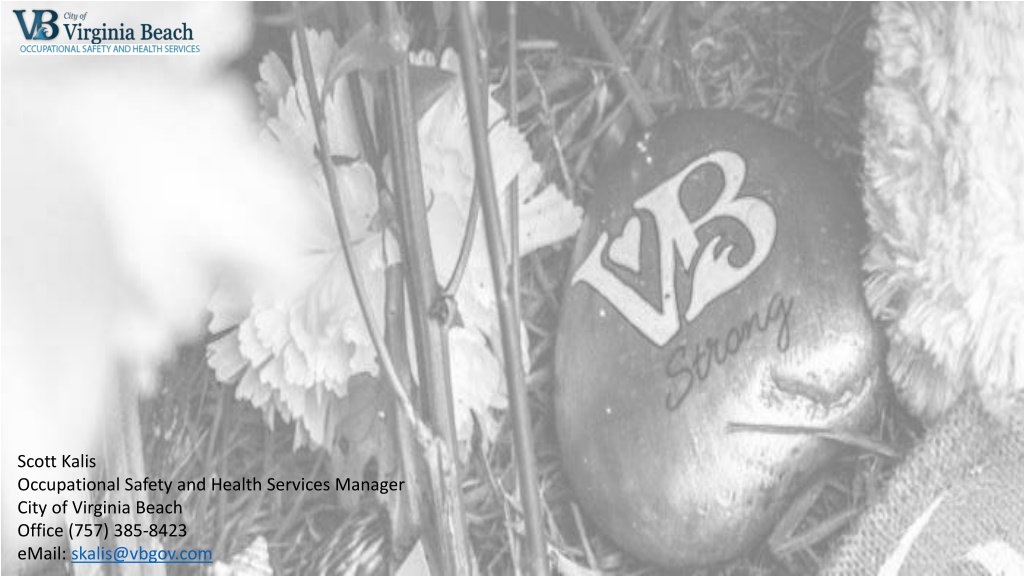


![Workplace Violence Prevention Plan in [District]: Definitions, Elements, and Implementation](/thumb/117038/workplace-violence-prevention-plan-in-district-definitions-elements-and-implementation.jpg)
